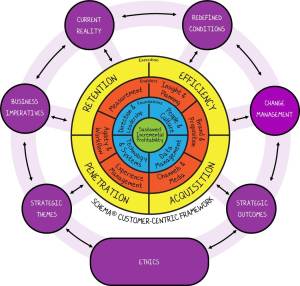Designing and executing a customer-centric business model requires end to end organisational alignment. Customer-centric capability development cannot take place in isolation to the rest of the business. The customer-centric journey requires a clear quantified understanding of current organisational capability across all 14 capability areas of the SCHEMA® Customer Management framework in the centre of the REAP Customer-Centric Blueprint below. As important as an understanding of current customer management capability is, so too is an understanding of the capability to which the organisation aspires.
Each week I’ll address another single capability area, sharing with you the Transformation Intent to which your organisation should commit to, as well as ‘What Good Looks Like’ for those organisations that have achieved a fairly high level of maturity in the respective capability area.
The REAP Customer-Centric Organisation Blueprint®

This week we are dealing with Brand & Proposition which is one of the six Enabling capability areas represented. The Enablers explore the components needed to energise your transformation and will invariably involve changes that can be planned for within the current business cycle, for implementation in the next budgetary or operating period. These components support your capability to implement your chosen customer strategies and rely on the fundamental building blocks (Foundations) already discussed in Part 1 to 4 of this series of blog posts.
Transformation Intent – Brand and Proposition
“Customer-centricity recognises and encourages the value of brand equity as an intangible asset, which is not created through gimmicks, but through an emotional connection with customers that communicates a clear value proposition and engages their participation in the creation of that proposition. Transform your approach to the design and development of your products and services by embracing customer-focused change and innovating on behalf of your customers, while keeping your eye on the competition.”
What Good Looks Like – Brand and Proposition
- The customer proposition/s and experience are clearly recognised and managed as being inextricably linked to the organisation’s brand/s. Each deeply informs the other.
- The overall proposition is clearly defined, easily understood and the organisation checks that staff & partners can communicate it effectively and that customers at least understand it. Innovation in terms of proposition is actively stimulated, managed and rewarded in staff and partners.
- There is a spirit and strategy of co-creation in everything that the organisation does. This does not mean ‘management by committee’, but a willingness to look for ideas and innovation from as diverse an audience as possible.
- The overall proposition is also tailored for at least the most important customer segments with processes in place to prevent ‘leakage’ of proposition elements from higher value to lower value segments.
- The way that the proposition/s compares to those of competitors, its relative strengths and weaknesses and how those should be used at the front line, is understood and communicated.
For more insight into customer-centric business model innovation as well as more insight into this particular area of the REAP Customer-Centric Blueprint, please see my book “The Customer-Centric Blueprint’ – http://amzn.to/ZILg4y
Filed under: 21st Century Organisation, Best Practice, Business Models, Change Management, Competitive Advantage, CRM Models, Customer Centricity, Customer Experience, customer management, Customer Relationship Management, Customer Strategy, Customer-centric government, Frameworks, Innovation, Leadership, Sustainable Business Performance Tagged: | 21st century organisations, Big Thinking, business innovation, business performance, business strategy, capability areas, capability development, company strategy, CRM, customer experience management, EVA, Inspiration, organisational alignment, thinking customer, Vision



